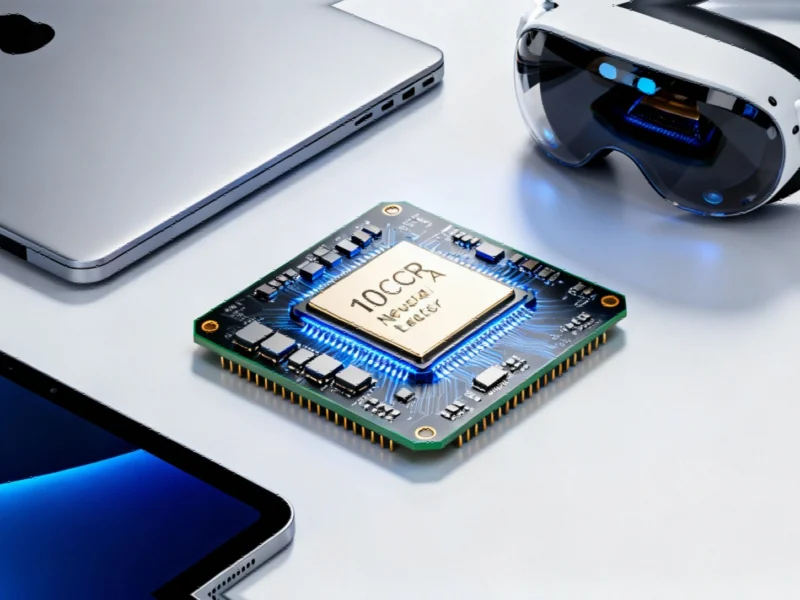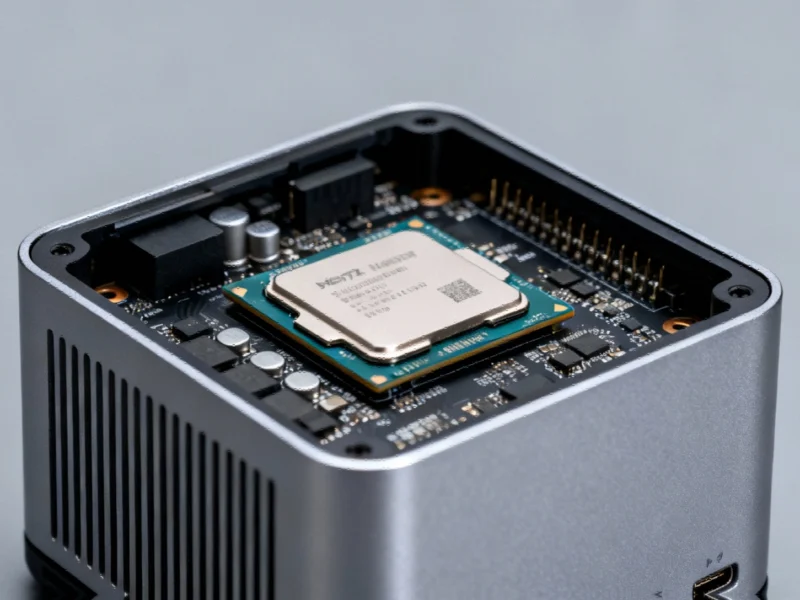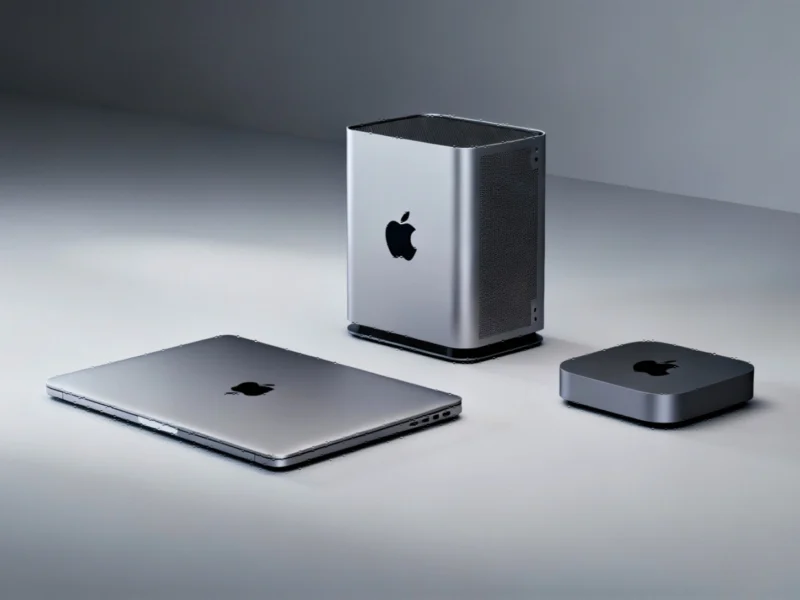Apple’s Next-Generation Silicon Arrives
Apple has officially unveiled its M5 chipset across three flagship professional devices, marking a significant leap in artificial intelligence capabilities and graphics performance. The new silicon represents Apple’s most aggressive push yet into AI-optimized computing, with all three M5-powered devices now available for preorder ahead of their October 22 sales launch. This strategic rollout across the MacBook Pro, iPad Pro, and Vision Pro lines demonstrates Apple’s commitment to creating a unified AI ecosystem, as detailed in Industrial Computing News’ comprehensive coverage of the M5 chipset deployment.
The timing of this announcement comes as competitors like ASUS breaks new ground with AMD-powered ROG NUC gaming systems, highlighting the intensifying competition in the high-performance computing space. Apple’s M5 chipset appears positioned to dominate the professional creative and AI development markets with its specialized architecture.
M5 Chipset: Architectural Breakthrough
Built on an advanced 3nm process, the Apple M5 processor represents what the company describes as “the next big leap in AI performance for Apple silicon.” The architecture features a next-generation 10-core GPU with dedicated Neural Accelerators integrated into each core, specifically optimized for AI workloads and graphics processing. Apple claims this configuration delivers over 4x the peak GPU compute performance for AI tasks and 45% higher ray tracing performance compared to the previous-generation M4 chipset.
The CPU configuration consists of six efficiency cores and up to four performance cores, delivering a 15% performance gain over M4. This is complemented by an improved 16-core Neural Engine that provides nearly 30% increase in unified memory bandwidth, reaching 153GB/s. This memory architecture enhancement is particularly crucial for AI workloads that require rapid access to large datasets.
14-inch MacBook Pro: Professional Workstation Upgrade
The base 14-inch MacBook Pro receives substantial upgrades with the M5 chipset, including faster internal storage and significant performance improvements. Apple states the new configuration provides a 3.5x AI performance boost and 1.6x faster graphics compared to the M4-powered MacBook Pro. Multithreaded performance sees a 20% improvement, while memory bandwidth increases to 153Gbps from the previous 120Gbps.
Notably, Apple has expanded storage options for the base model, now offering up to 4TB configurations that were previously reserved for M4 Pro and M4 Max models. Battery life remains impressive at up to 24 hours on a single charge. Pricing starts at $1,599 for the configuration with 10-core CPU, 10-core GPU, and 16GB of memory, while maintaining the same I/O ports, color options, and build quality as the previous generation.
M5 iPad Pro: Mobile AI Powerhouse
The M5 iPad Pro represents Apple’s most powerful tablet ever, delivering what the company describes as a “big leap in AI performance.” The device achieves 3.5x the AI performance of the M4 iPad Pro and up to 5.6x faster performance compared to M1-powered models. Beyond the processor upgrade, the tablet introduces Apple’s new C1X cellular modem on cellular variants and the N1 chip for enhanced Wi-Fi, Bluetooth, and Thread connectivity.
One of the most practical improvements comes in charging technology, with the device capable of reaching 50% charge within 30 minutes. The M5 iPad Pro continues to be available in two sizes: the 11-inch model starting at $999 and the 13-inch Pro model at $1,299. Display quality, anti-reflective coating, storage options, and the signature thin design remain consistent with previous generations.
Vision Pro: Enhanced Spatial Computing
The M5-powered Vision Pro headset receives both performance and comfort upgrades, featuring an all-new soft, cushioned Dual Knit Band for improved wearability. The M5 chipset enables faster app loading and more responsive web browsing, while the custom micro-OLED displays now feature 10% more pixels than the previous generation. Display refresh rates can now reach 120Hz, up from the previous maximum of 100Hz.
Battery life sees meaningful improvements, with the headset lasting 30 minutes longer than before for total usage times of up to 2.5 hours for general use and three hours for video playback. Pricing remains at $3,500 with storage options of 256GB, 512GB, and 1TB. This enhanced spatial computing experience arrives as Microsoft unveils conversational AI agents for Windows platforms, indicating broader industry momentum toward AI-integrated computing experiences.
Industry Implications and Competitive Landscape
Apple’s comprehensive M5 rollout signals a strategic focus on AI-accelerated computing across its professional product lines. The company emphasizes that the new processor enables dramatically accelerated processing for AI-driven workflows, including running large language models locally and operating diffusion models in applications like Draw Things. This positions Apple devices as viable platforms for on-device AI development and deployment.
The timing of these announcements coincides with broader industry movements toward AI integration, similar to how music streaming services are forming AI alliances to enhance recommendation engines. Apple’s approach distinguishes itself by focusing on hardware-level AI acceleration rather than purely cloud-based solutions, potentially setting new standards for on-device AI performance in professional computing environments.
Early indications suggest the M5 chipset represents more than just incremental improvements, potentially redefining performance expectations for mobile workstations, professional tablets, and spatial computing devices. As these devices reach consumers and professionals later this month, the real-world impact of Apple’s AI-optimized architecture will become clearer, potentially influencing the entire computing industry’s direction in AI hardware development.
Based on reporting by {‘uri’: ‘zdnet.com’, ‘dataType’: ‘news’, ‘title’: ‘ZDNet’, ‘description’: ‘ZDNets breaking news, analysis, and research keeps business technology professionals in touch with the latest IT trends, issues and events.’, ‘location’: {‘type’: ‘place’, ‘geoNamesId’: ‘5391959’, ‘label’: {‘eng’: ‘San Francisco’}, ‘population’: 805235, ‘lat’: 37.77493, ‘long’: -122.41942, ‘country’: {‘type’: ‘country’, ‘geoNamesId’: ‘6252001’, ‘label’: {‘eng’: ‘United States’}, ‘population’: 310232863, ‘lat’: 39.76, ‘long’: -98.5, ‘area’: 9629091, ‘continent’: ‘Noth America’}}, ‘locationValidated’: False, ‘ranking’: {‘importanceRank’: 189772, ‘alexaGlobalRank’: 3135, ‘alexaCountryRank’: 2012}}. This article aggregates information from publicly available sources. All trademarks and copyrights belong to their respective owners.



